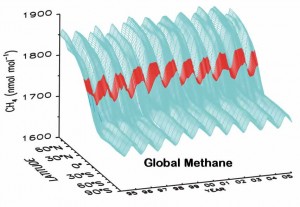U.S. Methane Emissions 50 Percent Higher Than EPA Estimates
Article from Harvard School of Engineering and Applied Sciences, November 26, 2013
Emissions of methane from fossil fuel extraction and refining activities in the South Central U.S. are nearly five times higher than previous estimates, according to researchers at Harvard University and seven other institutions. Their study, published this week in Proceedings of the National Academy of Sciences (PNAS), also suggests that the contribution from livestock operations may be twice as high as previously thought.
Overall, according to the new study, total methane emissions in the U.S. appear to be 1.5 times and 1.7 times higher than the amounts previously estimated by the U.S. Environmental Protection Agency (EPA) and the international Emissions Database for Global Atmospheric Research(EDGAR), respectively.
The difference lies in the methodology. The EPA and EDGAR use a bottom-up approach, calculating total emissions based on “emissions factors”—the amount of methane typically released per cow or per unit of coal or natural gas sold, for example. The new study takes a top-down approach, measuring what is actually present in the atmosphere and then using meteorological data and statistical analysis to trace it back to regional sources.
“The bottom-up and top-down approaches give us very different answers about the level of methane gas emissions,” notes lead author Scot M. Miller, a doctoral student in Earth and Planetary Sciences through the Harvard Graduate School of Arts and Sciences. “Most strikingly, our results are higher by a factor of 2.7 over the South Central U.S., which we know is a key region for fossil-fuel extraction and refining. It will be important to resolve that discrepancy in order to fully understand the impact of these industries on methane emissions.”
“When we measure methane gas at the atmospheric level, we’re seeing the cumulative effect of emissions that are happening at the surface across a very large region,” says Wofsy, a coauthor of the PNAS study. “That includes the sources that were part of the bottom-up inventories, but maybe also things they didn’t think to measure.”
Miller and Wofsy, along with colleagues at the Carnegie Institution for Science, the National Oceanic and Atmospheric Administration (NOAA), and five other institutions, used a combination of observation and modeling to conduct their analysis.
NOAA and the U.S. Department of Energy collect observations of methane and other gases from the tops of telecommunications towers, typically about as tall as the Empire State Building, and during research flights. The team combined this data with meteorological models of the temperatures, winds and movement of air masses from the same time period, and then used a statistical method known as geostatistical inverse modeling to essentially run the model backward and determine the methane’s origin.
The team also compared these results with regional economic and demographic data, as well as other information that provided clues to the sources—for example, data on human populations, livestock populations, electricity production from power plants, oil and natural gas production, production from oil refineries, rice production and coal production. In addition, they drew correlations between methane levels and other gases that were observed at the time. For example, a high correlation between levels of methane and propane in the South Central region suggests a significant role for fossil fuels there.
“This paper provides the most solid and the most detailed estimate to date of total U.S. methane emissions,” says coauthor Anna M. Michalak, a faculty member in the Department of Global Ecology at the Carnegie Institution for Science. Michalak is also an associate professor of environmental Earth system science at Stanford University. “This was really, from beginning to end, just a very clean analysis.”
Seeking to establish a baseline against which to measure future change in methane emissions, the researchers compared observational data collected in 2007–2008 against EDGAR and EPA data for the same year (using the revised EPA data for 2007–2008 that was published in April 2013). Future studies will apply the same analysis to present-day data.
“The beauty of the approach we’re using is that, because we’re taking measurements in the atmosphere, which carry with them a signature of everything that happened upwind, we get a very strong number on what that total should be,” says Michalak. “Now that we know the total does not equal the sum of the parts, that means that either some of those parts are not what we thought they were, or there are some parts that are simply missing from the inventories. It really offers an opportunity for governments to reexamine the inventories in light of what we now know.”

